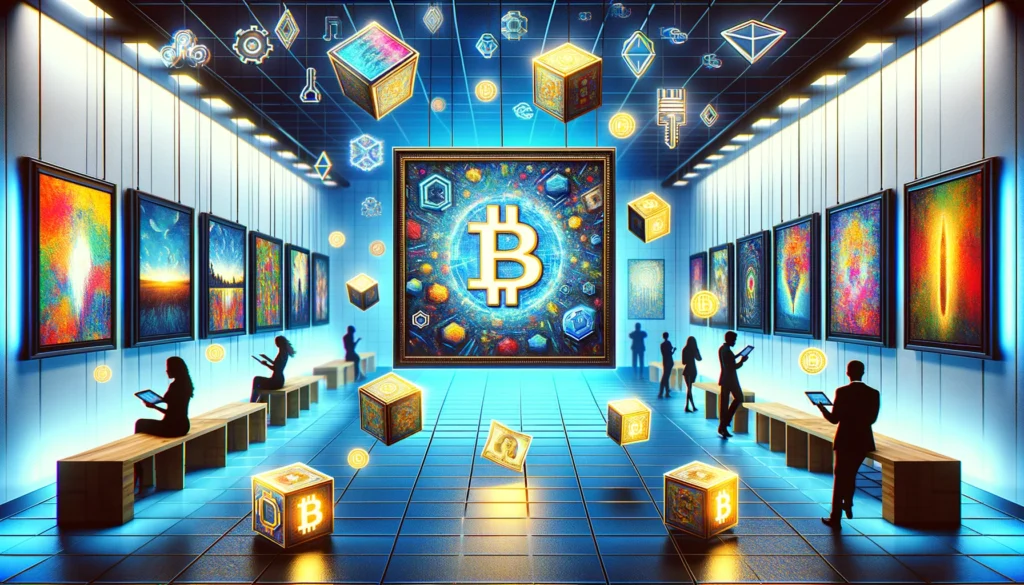Non-Fungible Tokens, or NFTs are unique digital assets that change our perception of ownership and value in the digital realm. This guide aims to demystify NFTs for newcomers in the cryptocurrency market, offering an in-depth understanding of what what are NFTs and why are they Valuable, why they’re valuable, and how they are reshaping the landscape of digital transactions.
Understanding NFTs: The Basics
Non-Fungible Tokens (NFTs) represent a revolutionary concept in the digital world. Unlike traditional cryptocurrencies like Bitcoin or Ethereum, which are fungible and can be exchanged on a one-to-one basis, NFTs are unique. Each NFT has a distinct digital signature, making it impossible to be exchanged on a like-for-like basis, hence ‘non-fungible’.
At their core, NFTs are digital assets that represent real-world objects like art, music, in-game items, and videos. They are bought and sold online, frequently with cryptocurrency, and they are generally encoded with the same underlying software as many cryptos.
What sets NFTs apart is their built-in authentication, which serves as proof of ownership. This is crucial in the digital world where duplication is easy. Owning an NFT means having the ownership rights to the original item, not just a copy. It’s like owning an original painting versus a print.
The technology behind NFTs, blockchain, ensures the authenticity and scarcity of these digital assets. Primarily hosted on the Ethereum blockchain, NFTs are stored in a way that verifies their uniqueness and ownership, providing a level of security and trust that is crucial in the digital market.
The History of NFTs
The journey of NFTs began before the term even existed. One of the earliest examples is the project ‘Quantum’ by Kevin McCoy, minted in 2014. However, NFTs gained significant public attention with the launch of CryptoKitties in 2017, a blockchain game on Ethereum that allowed players to purchase, collect, breed, and sell virtual cats.
Over time, NFTs have evolved from simple digital representations to complex assets that are part of a broader ecosystem of digital goods. The significant turning point came with the sale of digital artist Beeple’s artwork for $69 million in 2021. This sale not only catapulted NFTs into the limelight but also showcased their potential as a serious asset class in the digital economy.
How Do NFTs Work
NFTs operate on blockchain technology. Each NFT contains distinguishing information that makes it distinct from any other NFT and easily verifiable. This makes the creation and ownership of digital assets straightforward and secure.
The process of creating an NFT, known as ‘minting,’ involves turning a digital file into a blockchain-based digital asset. This digital asset is stored in a decentralized database and cannot be edited, deleted, or duplicated. The minting process includes writing a smart contract, which is a set of rules governing the NFT’s properties and interactions.
Ownership and provenance of NFTs are transparent and immutable. When you buy an NFT, you acquire the ownership rights to the unique token on the blockchain. However, it’s important to note that while you may own the NFT, the rights to the intellectual property of the digital asset can vary and are defined by the original creator.
Why are NFTs Valuable

The value of NFTs comes from their uniqueness and the digital ownership they offer. In a world where digital replication is easy and widespread, NFTs provide a way to certify and own original digital assets. The value of an NFT is subjective and can be influenced by factors like the creator’s reputation, rarity, and the asset’s history.
For example, digital artist Beeple’s NFT sold for $69 million, partly due to his fame and the artwork’s uniqueness. Similarly, the first tweet by Twitter’s founder, Jack Dorsey, was sold as an NFT for over $2.9 million. The high value of these NFTs is driven by the collector’s belief in their long-term worth, making them similar to traditional art investments.
The concept of digital ownership also extends to virtual real estate and collectibles in online platforms. NFTs allow users to own a piece of digital history, whether it’s a piece of virtual land in a blockchain-based game or a rare digital collectible.
Types of NFTs
NFTs come in various forms, each with unique characteristics and uses. Understanding these types can help potential buyers and traders to make informed decisions.
Digital Art
Perhaps the most well-known type of NFT, digital art ranges from illustrations and animations to complex 3D models. These NFTs have revolutionized the art world by providing artists with a platform to sell their digital works directly to collectors without intermediaries, ensuring authenticity and ownership.
Collectibles
Digital collectibles, such as virtual trading cards, limited edition items, or unique avatars for games, have a substantial market. These items often hold sentimental value and can sometimes offer in-game advantages, making them highly sought after.
Utility NFTs
These NFTs offer more than just ownership; they provide access to services or benefits. For instance, an NFT could grant access to exclusive events, serve as a membership card, or even represent a stake in a project, granting the holder certain rights or rewards.
Virtual Real Estate
In virtual worlds and metaverses, NFTs can represent ownership of virtual land and properties. This type of NFT has gained significant attention as these digital spaces grow in popularity and offer new opportunities for investment, advertising, and social interactions.
How to Buy and Sell NFTs
Trading NFTs requires understanding the platforms and the process involved.
Popular platforms like OpenSea and Rarible provide marketplaces for buying and selling NFTs. These platforms offer various categories of NFTs and facilitate the transaction process through blockchain technology.
Purchasing an NFT involves setting up a digital wallet, purchasing cryptocurrency (usually Ethereum), and then using it to buy NFTs on the chosen platform. It’s essential to research the NFT before purchasing, considering factors like its history, rarity, and the creator’s reputation.
To sell an NFT, you need to mint it if it’s your creation or list it on a marketplace if you already own it. Setting the right price is crucial and can depend on various factors, including the NFT’s uniqueness, demand, and the current market trend.
Risks and Considerations
While NFTs offer exciting opportunities, they also come with risks and considerations that should not be overlooked.
The NFT market, like the broader cryptocurrency market, is highly volatile. Prices can fluctuate dramatically, influenced by trends, hype, and speculation. Potential buyers and sellers should be aware of this volatility and consider the risks before investing.
Understanding the intellectual property rights associated with an NFT is crucial. Owning an NFT does not necessarily mean owning the copyright to the underlying digital asset. Buyers should research and understand what they are purchasing and the legal rights that come with it.
Future of NFTs
The NFT market is still in its infancy, and its future holds numerous possibilities. Advancements in blockchain technology, such as Ethereum’s planned shift to a more energy-efficient proof-of-stake model, may address current environmental concerns and improve the scalability and accessibility of NFTs.
Beyond digital art and collectibles, NFTs are expected to find new applications in various fields like gaming, virtual reality, and even in legal documents and real estate for digital identity and ownership verification.
The market for NFTs is likely to continue evolving, with potential for both growth and consolidation. As the concept becomes more mainstream, it could attract a wider audience, but this also means the market might undergo corrections and stabilization.
Conclusion
NFTs represent a fascinating blend of technology, art, and finance, offering a new way of understanding ownership and value in the digital age. For new cryptocurrency traders, the world of NFTs opens up a realm of possibilities, but it also demands careful consideration and ongoing learning. As the market evolves, staying informed and cautious will be key to navigating this dynamic space successfully.

